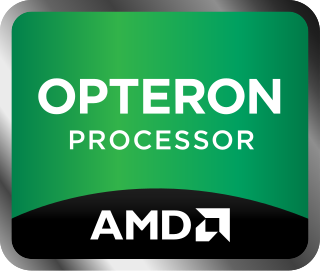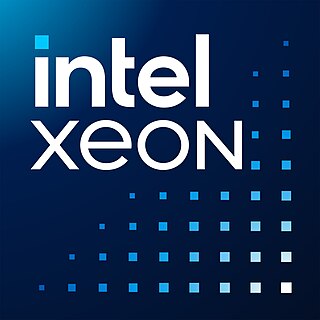
Duron is a line of budget x86-compatible microprocessors manufactured by AMD and released on June 19, 2000. Duron was intended to be a lower-cost offering to complement AMD's then mainstream performance Athlon processor line, and it also competed with rival chipmaker Intel's Pentium III and Celeron processor offerings. The Duron brand name was retired in 2004, succeeded by the AMD's Sempron line of processors as their budget offering.

Celeron is a discontinued series of low-end IA-32 and x86-64 computer microprocessor models targeted at low-cost personal computers, manufactured by Intel. The first Celeron-branded CPU was introduced on April 15, 1998, and was based on the Pentium II.
IA-64 is the instruction set architecture (ISA) of the discontinued Itanium family of 64-bit Intel microprocessors. The basic ISA specification originated at Hewlett-Packard (HP), and was subsequently implemented by Intel in collaboration with HP. The first Itanium processor, codenamed Merced, was released in 2001.

Pentium 4 is a series of single-core CPUs for desktops, laptops and entry-level servers manufactured by Intel. The processors were shipped from November 20, 2000 until August 8, 2008. It was removed from the official price lists starting in 2010, being replaced by Pentium Dual-Core.

The Pentium II brand refers to Intel's sixth-generation microarchitecture ("P6") and x86-compatible microprocessors introduced on May 7, 1997. Containing 7.5 million transistors, the Pentium II featured an improved version of the first P6-generation core of the Pentium Pro, which contained 5.5 million transistors. However, its L2 cache subsystem was a downgrade when compared to the Pentium Pro's.

Opteron is AMD's x86 former server and workstation processor line, and was the first processor which supported the AMD64 instruction set architecture. It was released on April 22, 2003, with the SledgeHammer core (K8) and was intended to compete in the server and workstation markets, particularly in the same segment as the Intel Xeon processor. Processors based on the AMD K10 microarchitecture were announced on September 10, 2007, featuring a new quad-core configuration. The last released Opteron CPUs are the Piledriver-based Opteron 4300 and 6300 series processors, codenamed "Seoul" and "Abu Dhabi" respectively.

Xeon is a brand of x86 microprocessors designed, manufactured, and marketed by Intel, targeted at the non-consumer workstation, server, and embedded markets. It was introduced in June 1998. Xeon processors are based on the same architecture as regular desktop-grade CPUs, but have advanced features such as support for error correction code (ECC) memory, higher core counts, more PCI Express lanes, support for larger amounts of RAM, larger cache memory and extra provision for enterprise-grade reliability, availability and serviceability (RAS) features responsible for handling hardware exceptions through the Machine Check Architecture (MCA). They are often capable of safely continuing execution where a normal processor cannot due to these extra RAS features, depending on the type and severity of the machine-check exception (MCE). Some also support multi-socket systems with two, four, or eight sockets through use of the Ultra Path Interconnect (UPI) bus, which replaced the older QuickPath Interconnect (QPI) bus.

The POWER5 is a microprocessor developed and fabricated by IBM. It is an improved version of the POWER4. The principal improvements are support for simultaneous multithreading (SMT) and an on-die memory controller. The POWER5 is a dual-core microprocessor, with each core supporting one physical thread and two logical threads, for a total of two physical threads and four logical threads.

POWER7 is a family of superscalar multi-core microprocessors based on the Power ISA 2.06 instruction set architecture released in 2010 that succeeded the POWER6 and POWER6+. POWER7 was developed by IBM at several sites including IBM's Rochester, MN; Austin, TX; Essex Junction, VT; T. J. Watson Research Center, NY; Bromont, QC and IBM Deutschland Research & Development GmbH, Böblingen, Germany laboratories. IBM announced servers based on POWER7 on 8 February 2010.

The Athlon 64 X2 is the first native dual-core desktop central processing unit (CPU) designed by Advanced Micro Devices (AMD). It was designed from scratch as native dual-core by using an already multi-CPU enabled Athlon 64, joining it with another functional core on one die, and connecting both via a shared dual-channel memory controller/north bridge and additional control logic. The initial versions are based on the E stepping model of the Athlon 64 and, depending on the model, have either 512 or 1024 KB of L2 cache per core. The Athlon 64 X2 can decode instructions for Streaming SIMD Extensions 3 (SSE3), except those few specific to Intel's architecture. The first Athlon 64 X2 CPUs were released in May 2005, in the same month as Intel's first dual-core processor, the Pentium D.
The Intel Core microarchitecture is a multi-core processor microarchitecture launched by Intel in mid-2006. It is a major evolution over the Yonah, the previous iteration of the P6 microarchitecture series which started in 1995 with Pentium Pro. It also replaced the NetBurst microarchitecture, which suffered from high power consumption and heat intensity due to an inefficient pipeline designed for high clock rate. In early 2004 the new version of NetBurst (Prescott) needed very high power to reach the clocks it needed for competitive performance, making it unsuitable for the shift to dual/multi-core CPUs. On May 7, 2004 Intel confirmed the cancellation of the next NetBurst, Tejas and Jayhawk. Intel had been developing Merom, the 64-bit evolution of the Pentium M, since 2001, and decided to expand it to all market segments, replacing NetBurst in desktop computers and servers. It inherited from Pentium M the choice of a short and efficient pipeline, delivering superior performance despite not reaching the high clocks of NetBurst.
The AMD Family 10h, or K10, is a microprocessor microarchitecture by AMD based on the K8 microarchitecture. The first third-generation Opteron products for servers were launched on September 10, 2007, with the Phenom processors for desktops following and launching on November 11, 2007 as the immediate successors to the K8 series of processors.

Microsoft XCPU, codenamed Xenon, is a CPU used in the Xbox 360 game console, to be used with ATI's Xenos graphics chip.

The Pentium Dual-Core brand was used for mainstream x86-architecture microprocessors from Intel from 2006 to 2009, when it was renamed to Pentium. The processors are based on either the 32-bit Yonah or 64-bit Merom-2M, Allendale, and Wolfdale-3M core, targeted at mobile or desktop computers.

Phenom II is a family of AMD's multi-core 45 nm processors using the AMD K10 microarchitecture, succeeding the original Phenom. Advanced Micro Devices released the Socket AM2+ version of Phenom II in December 2008, while Socket AM3 versions with DDR3 support, along with an initial batch of triple- and quad-core processors were released on February 9, 2009. Dual-processor systems require Socket F+ for the Quad FX platform. The next-generation Phenom II X6 was released on April 27, 2010.

The UltraSPARC II, code-named "Blackbird", is a microprocessor implementation of the SPARC V9 instruction set architecture (ISA) developed by Sun Microsystems. Marc Tremblay was the chief architect. Introduced in 1997, it was further development of the UltraSPARC operating at higher clock frequencies of 250 MHz, eventually reaching 650 MHz.

Athlon II is a family of AMD multi-core 45 nm central processing units, which is aimed at the budget to mid-range market and is a complementary product lineup to the Phenom II.













